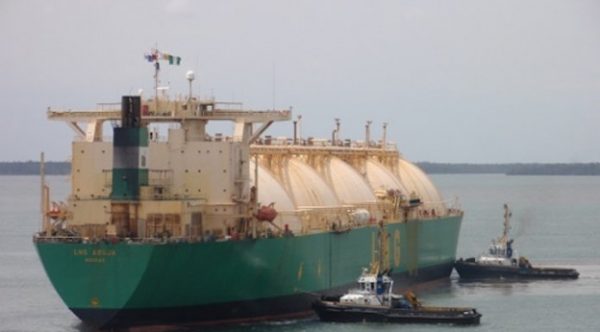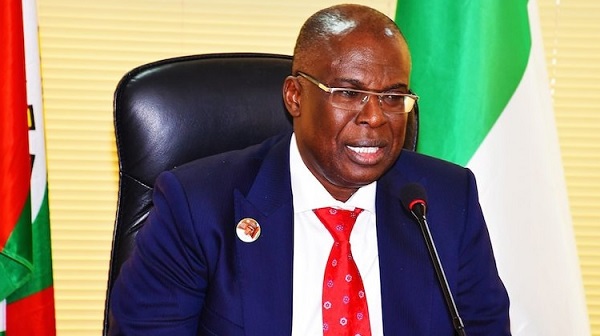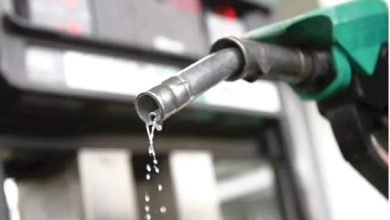Cooking Gas Scarcity Looms as NIMASA Detains NLNG Vessel
- Bans waivers, commences clampdown on foreign vessels
- NNPC’s refineries record N137.5bn operational losses
Nigerians may experience scarcity of Liquefied Petroleum Gas (LPG), better known as cooking gas, following the detention of NLNG Limited’s vessel by the Nigerian Maritime Administration and Safety Agency (NIMASA) over alleged violation of the Cabotage Act, media has learnt.
It was gathered that the detention of ‘MT Navigator Capricorn,’ the only vessel that supplies cooking gas to Nigeria’s domestic market, has created supply crisis, leading to a hike in the price of the product.
The maritime regulator yesterday also said it had commenced clampdown on vessels that do not comply with the provisions of the Cabotage Compliance Strategy introduced last year, to ease the implementation of the Cabotage Act of 2003.
The vessel, which brought 13,000 metric tonnes of LPG to Lagos from NLNG’s Bonny Island plant in Rivers State, was detained for about 10 days by NIMASA at the NOJ Jetty at Apapa after it had discharged its product.
NLNG brought in the new vessel to replace ‘MT Gas Providence,’ which used to supply LPG to the domestic market.
Media investigation revealed that the new vessel, which started operation in the country in 2018 brings in LPG every two weeks to Lagos for the licensed off takers appointed by the NLNG to distribute LPG to the domestic market.
However, the refusal of the maritime regulator to allow the vessel to sail back to Bonny Island to continue its two-weekly voyage to Lagos, created supply crisis.
The development, it was learnt, has already led to a hike in the cost of cooking gas in the country.
For instance, a 20MT tanker of LPG, which cost N3.7 million before the crisis, was selling for N4.15 million at the weekend, while a 12.5kg LPG cylinder, which cost N3,200 was selling for N3,800 in some places in Lagos at the weekend.
LPG marketers who spoke to media confirmed that the supply of the product was facing some threats with the arrest of major vessel supplying the product by NIMASA in the last one week.
According to one of the marketers, the vessel, which is on lease to NLNG since last year, has been having a running battle with NIMASA over its operations in Nigeria, being a foreign vessel.
The marketer said: “The issue got to its peak last week with NIMASA detaining the vessel at the NOJ, one of the berthing space specially dedicated at the NNPC-owned jetty at Apapa
“The vessel that berthed at the jetty about 10 days ago had finished discharging gas to major gas depots in Apapa, including NNPC, NIPCO, as well as 26 off takers of NLNG last weekend and was billed to sail away before NIMASA detained it.”
However, after series of negotiation between NIMASA, NLNG and key stakeholders in the LPG sector, the vessel was moved to safe anchorage to allow other operators access to NOJ Jetty, which is a very strategic berthing space at the Apapa jetty
Media source gathered that the NOJ is very key to LPG supply in Nigeria as it is the only jetty available for berthing of LPG vessels in Apapa axis where over 80 per cent of the entire LPG supply into the country is delivered to depots.
A top official of NIMASA, who spoke to media at the weekend, said the vessel was detained due to non-compliance with the Cabotage Act as it affects foreign vessels.
He explained: “Under the Cabotage Act, all foreign vessels operating charter services in Nigerian waters are supposed to have a certain number of Nigerians on board as part of its crew.
“However in the case of the detained vessel, it was not having Nigerians on board, which runs contrary to our laws.”
But an official of NLNG told media source on condition of anonymity that the company was aware of the provisions of the Cabotage Act, which stipulate that Nigerians must be on board foreign vessels operating in the country.
He, however, added that the safety standard set by NLNG for the vessel was too high that it would be difficult to get Nigerians with such high expertise to man the vessels.
“The safety standard set by the vessel owners and the NLNG is too high and it will be difficult to get Nigerians with such high expertise. NIMASA’s position is that we should even train Nigerians to acquire such skills but training Nigerians will take a long time,” he said.
“With the intervention of stakeholders, NIMASA released the vessel to sail away to the Bonny Island but the supply dislocation will not normalise until after the elections. In fact, the vessel will not be available until after the elections and this will create scarcity in the market,” he added.
The vessel, it was gathered, is on charter by NLNG for upward of about two years.
Meanwhile, NIMASA has stated that it has commenced clampdown on vessels that do not comply with the provisions of the Cabotage Compliance Strategy introduced last year, to ease the implementation of the Cabotage Act of 2003 in Nigeria.
In a statement yesterday, the Director-General of NIMASA, Dr. Dakuku Peterside, said the agency would no longer encourage the application of any form of waivers under the Cabotage Act, particularly from the oil firms operations as such do not help the growth of the Nigerian maritime sector and economy at large.
He said: “our laws forbid foreign vessels operating in our territorial waters save for compliance with the Cabotage Act. There shall be no sacred cow when we commence clampdown on erring vessels.
“We want to increase the number of Nigerians who participate in the marine aspect of your business and we are working closely with the Nigerian Content Development and Monitoring Board (NCDMB) to have a joint categorisation of vessels operating under the Cabotage Act in order to ensure the full implementation of the Act.”
Already, he said a detention order for a Motor Tanker, MT NAVIGATOR CAPRICORN, which is a LPG carrier, has been approved for contravening sections of the Cabotage Act.
The vessel, he stated, was first boarded in October 2018 and all infractions of Cabotage non-compliance were noted and communicated accordingly to the charterer/Owners representatives with a 90 days’ grace period to comply.
“The 90 days expired on January 31, 2019. It is noteworthy that the owners made undertaking to remedy the notable infractions when the vessel was issued a detention warning in October 2018.
“While NIMASA is currently engaging the owners and charterers of the vessel on the need to comply with the laws of the land, MT NAVIGATOR CAPRICORN has been moved to Lagos Anchorage to allow space for other LPG vessels to discharge at the NOJ Jetty, “he said.
Peterside had recently led the agency officials to meet with the Oil Producers Trade Sector (OPTS) in Lagos where he urged industry players to draw up a five-year strategic plan for the cessation of application for Cabotage waiver and also pursue the utilisation of Nigerian-owned vessels for marine contracts.
In August 2018, NIMASA had introduced a new Compliance Strategy for Cabotage Implementation in Nigeria to ensure full implementation of the Cabotage Act, 2003 to secure jobs for qualified Nigerians in the maritime sector.
The agency via a Marine Notice suspended considerations for applications of grant of waiver on manning for prescribed categories of officers in vessels engaged in Cabotage trade.
NNPC’s Refineries Record N137.5bn Operational Losses
The three refineries operated by the Nigerian National Petroleum Corporation (NNPC) in Warri, Port Harcourt, and Kaduna, made profit only once in the last 13 months and recorded a consolidated trading losses amounting to N137.489 billion, a monthly operations and financial report from the corporation has disclosed.
Obtained by media yesterday in Abuja, the report, which was for the month of November 2018, was posted on the official webpage of NNPC.
It showed that except for April 2018, when the refineries posted a consolidated trading surplus of N6.321 billion, its operational records in the other 12 months were all losses.
For instance, figures on the financial performance of the refineries between November 2017 and November 2018, indicated that in November 2017, they posted a deficit worth N11.144 billion; in December 2017, it was N11.095 billion; and then at the turn of the year 2018, they posted a consolidated loss of N13.586 billion.
The refineries continued their loss-making trends in February 2018 with a deficit of N8.055 billion; and N11.889 billion in March before turning around their fortunes in April to record a profit of N6.321 billion which was the only profit they ever made within the period.
Returning back to their loss-making inclinations, the refineries in May 2018 recorded their heaviest deficits with N20.081 billion netted in their books; N14.510 billion was again recorded against them in June; N10.449 billion in July; N10.793 billion in August; N6.972 billion in September; in October, it was N9.326 billion; and then N9.585 billion in November 2018.
With regards to capacity utilisation, the NNPC report noted that in November 2017, it was a combined efficiency of 5.81per cent, it rose to 26.99 per cent in December of the same year, and then dropped to 10.89 per cent in January 2018.
In February 2018, it rose slightly to 13.94 per cent; in March, it rose again to 14.41 per cent before sliding by more than half to seven per cent in April; and rising again to 20.12 per cent in May; 20.66 per cent in June; and then nosediving to 4.83 per cent July; and 3.02 per cent in August.
In September and October 2018, all of the corporation’s refineries had zero capacity utilisation indicating they perhaps produced nothing within these two months. They then picked up to a meagre 0.67 per cent capacity utilisation in November 2018.
Also, the report noted that their yields efficiency based on Crude Distillation Unit (CDU); Catalytic Reforming Unit (CRU); and Fluid Catalytic Cracking (FCC), the Port Harcourt refinery had the highest with 88.73 per cent, followed by Warri refinery which had 83.24 per cent, and then Kaduna refinery with 40.87 per cent over the period.
Over the period, the report equally stated that the refineries produced 842,109,103 litres of petrol and 406,065,675 litres of kerosene, out of the 20,084,584,883.64 litres of petrol and 601,483,991.02 litres of kerosene consumed in Nigeria.









